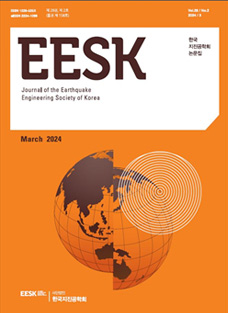1. Introduction
Currently more than 60% of existing buildings in Korea were built without considering seismic loads. After earthquakes with magnitude of 5.8 at Kyungjoo in 2016 and 5.3 at Pohang in 2017, there are huge demands for seismic retrofit of non-seismically designed buildings, especially school and government buildings. However conventional seismic retrofit methods such as jacketing of columns or placement of new shear walls are not preferred in practice because the local increase in stiffness and strength is often accompanied with reinforcement of the footing located below the retrofitted elements. Therefore more cost effective seismic retrofit methods are required for seismic retrofit of existing buildings.
Recently combined use of different seismic energy dissipation devices in the field of seismic retrofit of existing structures has been investigated by many researchers. Simultaneous application of multiple energy dissipation mechanisms has advantage in that multiple design objectives can be achieved by using multiple damping mechanisms. Many researchers have investigated the advantage of combined use of multiple dampers. For example, Marshall and Charney [1] studied a hybrid system with buckling restrained braces and viscous fluid device by investigating the seismic response of steel frame structures. Zahrai et al. [2] studied the combined retrofit effect of using friction dampers and masonry infill panels. Xu et al. [3] studied seismic performance and optimum design of hybrid damping mechanism including viscoelastic dampers. Lee et al. [4] investigated the effectiveness of a hybrid damper consisting of steel slit plate and rotational friction devices to be used effectively both for small and large earthquakes.
This study investigates the seismic performance of a hybrid damper in which steel slit plates and a viscoelastic pad are combined to be used for seismic retrofit of a structure. Viscoelastic dampers are effective when velocity is large, whereas slit dampers are effective at large displacement. The former is activated even at small displacement; however large amount of viscoelastic material is required to produce large damping force. The latter remains elastic at small displacement, but is effective in dissipating significant amount of seismic energy. By combining the two different dampers, it is expected that the hybrid dampers are more effective in reducing various structural responses caused by earthquakes with diverse dynamic characteristics. To minimize the number of hybrid dampers required to satisfy the target performance level, optimal story-wise damper installation scheme is developed using genetic algorithm. The probabilities of reaching various damage states before and after seismic retrofit are obtained by fragility analysis to evaluate the margin for safety against earthquakes, and the life cycle cost of the model structure is estimated to demonstrate the cost effectiveness of the seismic retrofit system.
2. Hybrid dampers used in the analysis
The hybrid damper investigated in this study is composed of viscoelastic pads and steel slit plates connected in parallel as shown in Fig. 1, where all components and installation scheme are depicted. The in-plane stiffness of the slit damper subjected to horizontal shear force can be obtained as follows based on the assumption that the ends of the narrow strips are fully restrained from rotation:(1)
where n = number of strips, t = thickness of strips, b = width of strips, and lo = length of the vertical strip.
Chan and Albermani [5] derived the yield strength of a slit damper assuming elastic–perfectly-plastic behavior. Plastic hinges form at both ends of the strip with the full plastic moment obtained by multiplication of the yield stress, σy, and the plastic section modulus. The yield force of the slit damper, Py, can be obtained as follows(2)
The behavior of a viscoelastic material is generally modeled by the Kelvin model which is composed of the stiffness, Kve, and the damping, Cve, connected in parallel. The stiffness and the damping of a viscoelastic damper are represented as follows using the storage modulus, G′, and the loss modulus, G′′ [3]:(3)(4)
where A and t are the area and the thickness of the viscoelastic material pad, and wis the natural frequency of the model structure.(5)
Fig. 2 depicts the mathematical model for the hybrid damper, where the viscoelastic damper and the slit damper are connected in parallel. In the figure Cve represents a linear dashpot, Kve a linear elastic spring, and Kslit represents a bilinear plastic spring. The nonlinear analysis software Perform-3D [6] is used for nonlinear dynamic analyses. The viscoelastic damper is modeled using the ‘Fluid Damper’ and ‘Elastic Bar’ elements connected in parallel, and the slit damper is modeled by the ‘Rubber Type Seismic Isolator Element’ which consists of nonlinear shear spring and axial spring. The bilinear stiffness of the shear spring is determined as the stiffness of the slit damper.
The dimensions and material properties of the VE dampers and the slit dampers used in the analysis are presented in Table 1 and Table 2, respectively.
3. Seismic retrofit of analysis model structures
The analysis model structure is a 9-story reinforced concrete (RC) moment frame designed only for dead and live loads of 4.3 kN/m2and 3.0 kN/m2, respectively. Fig. 3 depicts the structural plan and elevation of the model structure. All beams have sectional dimension of 500x300 mm. The size of external comumns varies from 500x500 mm in the first story to 400x400 mm at the top, and that of the internal comumns varies from 550x550 mm in the first story to 400x400 mm at the top story. The structure is designed to be symmetric so that it can be easily transformed into a multi-degrees of freedom system with only single degree of freedom per floor to be used for optimization process. The fundamental natural period of the model structure is computed to be 1.65 second. Fig. 4 Nonlinear model for structural members.
For seismic performance evaluation of the model structure, the design seismic load is computed based on the design spectral response acceleration parameters =0.53 g and =0.23 g. For RC moment resisting frame, the response modification factor and the deflection amplification factor specified in the ASCE/SEI 7-13 [7] are 3.0 and 2.5, respectively. The dampers are designed in such a way that the stiffness ratio of viscoelastic and slit damper is 0.55. For optimum distribution of the dampers and for seismic performance evaluation of the model structure, six earthquake records are selected from the PEER NGA Database [8], and are scaled to fit the design spectrum (Fig. 5). The nonlinear analysis program code Perform 3-D is used to estimate the seismic load resisting capability of the model structure.
4. Optimum distribution of hybrid dampers for seismic retrofit
In this section seismic retrofit of the model structure is carried out using the hybrid dampers optimally distributed by the genetric algorithm. Since huge number of nonlinear time history analyses are generally involved in the optimization process using genetic algorithm, the model structure is transformed into an equivalent 9 degrees of freedom system with a single degree of freedom per floor. The forcedisplacement relationship of each story of the equivalent structure is obtained from the pushover analysis of the original structure, and is tri-linearized for nonlinear analysis. Then the stiffness matrix of the system was modified in such a way that the first mode vibration period of the simplified model is equal to that of the original model.
Genetic algorithm (GA) is an effective search technique based on natural selection having advantage in that it is simple to apply and can easily be modified for a broad field of problems [9]. GA has basic operators such as selection, crossover, and mutation, which are applied on a population in each generation to improve their fitness. In the first step of the optimization process applied in this study, a number between 1~(29-1) is randomly selected and is changed to a binary number, which is allocated to a string or a gene composed of 9-bits which represent the degrees of freedom of the structure. The bits allocated with the number ‘1’ represent the stories with dampers and those with ‘0’ represent the stories without dampers. In the second step a random number is generated for yield force of the damper in each story. In this study total of 300 strings containing different information about story-wise distribution of damper slip force are randomly generated, and are put into breeding process over 1,000 generations until optimum solution is derived. The fitness value of each string of damper distribution, which is the maximum inter-story drift, is evaluated by nonlinear time history analysis of the equivalent 9-degrees of freedom system. In this study the genetic algorithm in the Global Optimization Toolbox in Matlab is applied to minimize the total amount of dampers installed for seismic retrofit. As a constraint the maximum inter-story drift is maintained to be below 1.5% of the story height, and the maximum number of dampers is limited to 6. The design objective to be optimized is to minimize the total amount of the dampers while the constraints are satisfied. Six earthquake records obtained from PEER NGA Database [8] are used for nonlinear dynamic analyses of the transformed 2D model structure to find the optimum damper distribution pattern using genetic algorithm.
Fig. 6 shows the optimum damper distribution pattern obtained from genetic algorithm averaged over six different results, where total of 15 dampers are installed throughout the stories of the 2D frame. Fig. 7 depicts the maximum inter-story drifts of the model structure subjected to the six earthquakes before and after seismic retrofit, where it can be observed that, after the retrofit with the 15 dampers optimally distributed using genetic algorithm, the given inter-story drift limit state of 1.5% of the story height is satisfied. Fig. 8 shows the maximum inter-story drifts of the model structure retrofitted with the same number of dampers uniformly distributed over the stories or distributed proportionally to the inter-story drift, where it can be observed that the limit state is not satisfied for most of the earthquake records. The comparison of the results presented in Fig. 7 and Fig. 8 demonstrates the effectiveness of the optimum distribution technique. Fig. 9 depicts the damage states on pushover curves of model structure before and after seismic retrofit. It can be noticed that after the seismic retrofit both the strength and deformation capacity at each limit state increase.
5. Failure probability of the model structure
Seismic fragility is the conditional probability that the structural capacity, C, fails to resist the structural demand, D, given the seismic intensity hazard, and is modeled using a lognormal cumulative distribution function as follows [10]:
where Φ[ ]= standard normal probability integral, =median structural capacity, associated with the limit state, and β= uncertainty in C.
To obtain seismic fragility of the model structure, incremental dynamic analyses are carried out using the 22 pairs of scaled far-field records obtained from the PEER NGA Database. Damping ratios of 5% are used for all vibration modes. Fig. 10 depicts the incremental dynamic analysis results of the model structures using the earthquake records. Based on the incremental dynamic analysis results, the median structural capacity or the spectral acceleration at which a limit state is reached by the 22nd earthquake record is determined. Then the probabilities of reaching the four damage states defined in the HAZUS [11], which are Slight, Moderate, Extensive, and Complete damage, are computed using Eq. (6). The Complete damage state is defined as the maximum inter-story displacement at which the strength decreases to 80% of the maximum strength in the pushover curve. The states of the Slight damage and the Moderate damage are defined as the spectral displacements corresponding to the 70% and the 100% of the yield point, respectively. The Extensive damage is defined as the quarter point from the Moderate to the Complete damage. In the incremental dynamic analysis, the upper bound of spectral acceleration is set to be 1.0 g because the median structural capacities for all damage states are reached below that level as can be observed in Fig. 10 and Fig. 11 depicts the fragility curves of the analysis model structure before and after the seismic retrofit using the hybrid dampers optimally distributed throughout the stories. The Complete damage state is defined as the maximum inter-story displacement at which the strength decreases to 80% of the maximum strength in the pushover curve. The states of the Slight damage and the Moderate damage are defined as the spectral displacements corresponding to the 70% and the 100% of the yield point, respectively. The Extensive damage is defined as the quarter point from the Moderate to the Complete damage. The analysis results show that the retrofitted structure has lower probability of reaching the given limit states. Especially the decrease in the probability of reaching the Complete damage state is the most significant. This implies that the application of the hybrid dampers is most effective in preventing total collapse of the model structure.
6. Conclusion
This study investigated the seismic performance of a hybrid seismic energy dissipation device composed of a viscoelastic damper and steel slit dampers connected in parallel. The effectiveness of the hybrid damper is investigated by fragility analysis and the life cycle cost evaluation of the structure with and without the dampers.
The analysis results showed that the distribution of hybrid dampers using genetic algorithm leaded to the optimum solution for damper design. The fragility analysis showed that the model structure retrofitted with the hybrid dampers had reduced probability of reaching given damage states, especially the complete damage state.

























